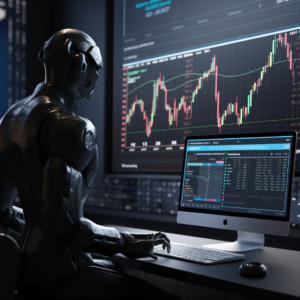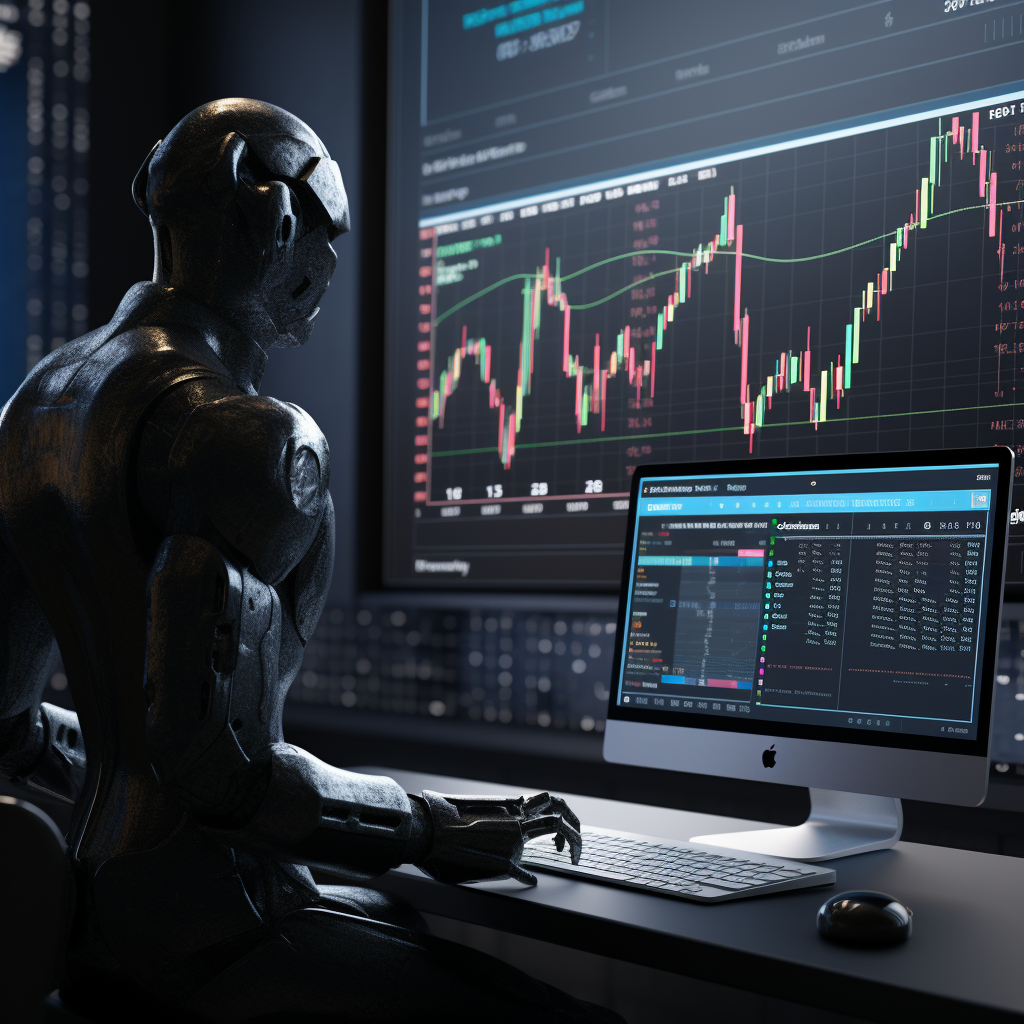AI-Based Trading Tools: Maximizing Profits in the Online Market
In today’s fast-paced and competitive online market, traders are constantly seeking ways to maximize their profits. One innovative solution that has gained significant traction is the use of AI-based trading tools. These tools leverage advanced algorithms, such as machine learning and natural language processing, to analyze real-time data, make predictions, and execute trades with minimal human intervention. In this article, we will explore the power of AI-based trading tools and how they can help traders maximize their profits in the online market.
Understanding AI-Based Trading Tools

What are AI-Based Trading Tools?
AI-based trading tools are sophisticated software applications that use artificial intelligence algorithms to automate trading processes. These tools are designed to analyze vast amounts of market data, identify trends, and execute trades based on predefined rules and strategies. By harnessing the power of AI, traders can make informed decisions quickly and efficiently.
Key Features of AI-Based Trading Tools
Real-Time Data Analysis:
One of the key features of AI-based trading tools is their ability to analyze real-time market data. These tools continuously monitor market conditions, track price movements, and identify trading opportunities in real-time. By leveraging real-time data analysis, traders can stay ahead of market trends and make timely trading decisions.
Predictive Analytics:
AI-based trading tools leverage cutting-edge predictive analytics to revolutionize the way traders approach the financial markets. These sophisticated tools harness the power of advanced algorithms, machine learning, and natural language processing to meticulously analyze vast amounts of historical data, intricate patterns, and crucial market indicators. By processing and interpreting this diverse range of information, AI-based trading tools can generate accurate predictions regarding the potential direction of market prices.
The strength of AI-based trading tools lies in their ability to uncover hidden patterns and trends within complex market data. These tools can identify subtle correlations, anomalies, and recurring patterns that may elude human analysis. By analyzing historical data, AI-based trading tools can discern patterns that may repeat in the future, providing traders with valuable insights to guide their decision-making process.
Furthermore, AI-based trading tools excel at analyzing multiple indicators simultaneously, allowing for a holistic assessment of market conditions. They can process a wide array of data, including market news, financial reports, social media sentiment, and more, enabling traders to gain a comprehensive understanding of the market landscape.
With their ability to generate accurate predictions, AI-based trading tools empower traders to make well-informed decisions. By leveraging the insights provided by these tools, traders can optimize their trading strategies, identify profitable entry and exit points, and manage risk more effectively. The accuracy and speed of predictive analytics offered by AI-based trading tools give traders a competitive edge, allowing them to capitalize on emerging opportunities and adapt to rapidly changing market conditions.
By embracing AI-based trading tools, traders can unlock a realm of unparalleled potential. These tools have the capacity to augment traders’ decision-making capabilities, enhance profitability, and streamline trading operations. They enable traders to overcome human limitations, such as cognitive biases and emotional decision-making, by providing objective and data-driven insights.
Moreover, AI-based trading tools continuously learn and adapt from new data, allowing them to refine their strategies over time. This iterative process enables traders to stay ahead of the curve and adapt to evolving market dynamics. It also ensures that traders are equipped with the most up-to-date information and insights to guide their trading decisions.
In conclusion, AI-based trading tools revolutionize the way traders approach the financial markets. Leveraging cutting-edge predictive analytics, these tools provide accurate predictions, uncover hidden patterns, and empower traders to make well-informed decisions. By embracing the revolutionary capabilities of AI, traders can unlock unparalleled potential and elevate their trading endeavors to unprecedented levels of success.
Pattern Recognition:
Pattern Recognition: Unlocking Profitable Trading Opportunities
Pattern recognition is a fundamental feature of AI-based trading tools that can greatly enhance a trader’s ability to identify and capitalize on profitable opportunities in the online market. By analyzing historical market data, these tools can detect recurring patterns and trends, enabling traders to make informed trading decisions. Let’s delve deeper into the concept of pattern recognition and explore its sub-sections:
I. Types of Patterns:
AI-based trading tools are designed to identify various types of patterns that occur in market data. Some common patterns include:
a. Trend Patterns:
– Trend patterns help traders identify the direction and strength of price movements over time.
– Examples of trend patterns include uptrends, downtrends, and sideways trends.
– By recognizing trend patterns, traders can enter positions that align with the prevailing market direction, increasing their chances of profitability.
b. Reversal Patterns:
– Reversal patterns indicate potential changes in the direction of price movements.
– Examples of reversal patterns include double tops, double bottoms, and head and shoulders patterns.
– Traders can use these patterns to anticipate trend reversals and adjust their trading strategies accordingly.
c. Continuation Patterns:
– Continuation patterns suggest that the existing trend is likely to continue after a brief pause or consolidation.
– Examples of continuation patterns include flags, pennants, and triangles.
– Recognizing continuation patterns can help traders stay in profitable trades and maximize their profits.
II. Importance of Pattern Recognition:
Pattern recognition is a powerful tool for traders as it provides valuable insights into market behavior and helps them make informed trading decisions. Here’s why pattern recognition is essential:
a. Increased Accuracy:
– By identifying patterns, traders can make more accurate predictions about future price movements.
– This allows them to enter trades with higher probabilities of success, boosting their overall profitability.
b. Enhanced Timing:
– Pattern recognition helps traders identify optimal entry and exit points for their trades.
– By entering trades at the right time, traders can maximize their profits and minimize potential losses.
c. Improved Risk-to-Reward Ratio:
– Recognizing patterns enables traders to define their risk-to-reward ratios more effectively.
– Traders can set stop-loss levels and profit targets based on the patterns they identify, ensuring a favorable risk-to-reward ratio.
III. Tools for Pattern Recognition:
AI-based trading tools employ various techniques and indicators to identify patterns in market data. Some common tools for pattern recognition include:
a. Moving Averages:
– Moving averages smooth out price data and help traders identify trends.
– Traders often use moving average crossovers to confirm trend reversals or continuation patterns.
b. Fibonacci Retracement:
– Fibonacci retracement levels help identify potential support and resistance levels based on the Fibonacci sequence.
– Traders use these levels to anticipate price reversals and adjust their trading strategies accordingly.
c. Candlestick Patterns:
– Candlestick patterns provide visual representations of price movements within a specific time frame.
– Traders can analyze candlestick patterns to identify trend reversals, continuation patterns, and potential entry or exit points.
IV. Backtesting and Pattern Recognition:
Backtesting is a critical process that allows traders to validate their pattern recognition strategies using historical data. By applying their pattern recognition techniques to past market data, traders can assess the effectiveness of their strategies, identify strengths and weaknesses, and refine their approach.
Implementing AI-Based Trading Tools
Implementing AI-based trading tools is a relatively straightforward process. Here are the steps to get started:
Step 1: Define Your Objectives:
Before implementing AI-based trading tools, it’s essential to define your trading objectives. Determine the markets you want to trade in, the level of automation you prefer, and the specific trading strategies you intend to implement.
Step 2: Gather Quality Data:
To ensure accurate predictions and optimal performance, AI-based trading tools require high-quality data. Gather market data from reliable sources and ensure that it is clean, up-to-date, and relevant to your trading objectives.
Step 3: Choose the Right Platform:
Select a reputable AI-based trading platform that aligns with your trading objectives. Consider factors such as ease of use, available features, and compatibility with your trading style.
Strategies for Maximizing Profits with AI-Based Trading Tools
Developing Effective Trading Strategies:
AI-based trading tools provide traders with a wide range of strategies to maximize profits. Whether it’s trend-following, mean reversion, or breakout strategies, these tools can help traders identify and execute profitable trades.
Backtesting:
Backtesting is a crucial step in maximizing profits with AI-based trading tools. It involves testing trading strategies using historical market data to evaluate their performance over time. By simulating trades and comparing the outcomes with actual market conditions, traders can assess the effectiveness of their strategies and make data-driven decisions to refine and improve their trading approach.
1. Testing Strategies:
Backtesting allows traders to test their strategies using historical data to understand how they would have performed in the past. By applying the strategy to different market conditions and time periods, traders can gain insights into its strengths and weaknesses. This helps identify which strategies are more likely to generate profitable trades and which may need adjustment.
2. Evaluation of Performance:
Backtesting helps traders evaluate the performance of their strategies objectively. By comparing the results of simulated trades with the actual market data, traders can assess the strategy’s accuracy, profitability, and risk management capabilities. This evaluation enables traders to identify any potential issues and make necessary adjustments to improve performance.
3. Refining Strategies:
Backtesting provides traders with valuable insights into the effectiveness of their trading strategies. By analyzing the results and identifying areas for improvement, traders can refine their strategies to enhance profitability. This may involve tweaking parameters, adding additional indicators, or adjusting risk management techniques.
4. Optimizing Risk-Reward Ratio:
Backtesting allows traders to optimize their risk-reward ratio by analyzing the historical performance of their strategies. By adjusting position sizing, stop-loss levels, and take-profit targets, traders can determine the optimal balance between risk and reward. This optimization helps maximize profits while minimizing potential losses.
5. Confidence Building:
Backtesting helps build confidence in trading strategies. By seeing positive results over various historical market conditions, traders gain conviction in their approach. This confidence can lead to more disciplined and consistent trading decisions, ultimately maximizing profits.
6. Identifying Market Conditions:
Backtesting enables traders to identify specific market conditions in which their strategies perform best. By analyzing the strategy’s performance during different market phases, such as trending or ranging markets, traders can tailor their approach to capitalize on favorable conditions and adjust their strategies for less favorable situations.
7. Continuous Improvement:
Backtesting is an iterative process that promotes continuous improvement. Traders can continually refine and optimize their strategies based on the insights gained from backtesting. Regularly reviewing and adjusting strategies based on historical performance helps traders adapt to evolving market conditions and maximize profitability.
In conclusion, backtesting is a crucial step in maximizing profits with AI-based trading tools. By using historical data to test and evaluate trading strategies, traders can refine their approaches, optimize risk-reward ratios, build confidence, and adapt to changing market conditions. It is an essential tool for traders to make data-driven decisions and improve their overall trading performance.
Challenges and Risks
While AI-based trading tools offer numerous benefits, it’s important to be aware of the challenges and risks involved:
Limitations of AI Algorithms:
AI algorithms have their limitations and may not always provide accurate predictions. Traders should exercise caution and use human judgment to validate AI-generated signals before executing trades.
Risk Management:
Maximizing profits in the online market requires effective risk management. Traders should set appropriate risk parameters, diversify their portfolios, and continuously monitor their AI-based trading systems.
Future Trends and Innovations
The field of AI-based trading tools is continuously evolving. Here are some future trends and innovations to watch out for:
Blockchain Technology:
Blockchain technology has the potential to revolutionize the online trading market. By providing transparent and secure transaction records, blockchain can enhance trust and efficiency in trading processes.
Quantum Computing:
Quantum computing holds tremendous promise for the future of AI-based trading tools. With its ability to process vast amounts of data and perform complex calculations at an unprecedented speed, quantum computing has the potential to revolutionize data analysis in the financial industry. Here’s how quantum computing can enhance AI-based trading tools and enable more accurate predictions:
1. Increased Processing Power:
Quantum computers can handle significantly larger datasets and perform computations at an exponential speed compared to classical computers. This means that AI-based trading tools powered by quantum computing can process vast amounts of market data in real-time, enabling traders to make faster and more informed decisions.
2. Enhanced Data Analysis:
Quantum computing’s computational power can unlock new possibilities for data analysis in AI-based trading. These systems can analyze multiple variables simultaneously, allowing for more comprehensive and nuanced analysis of market trends, patterns, and correlations. As a result, traders can gain deeper insights into market dynamics, leading to more accurate predictions.
3. Improved Machine Learning Models:
Quantum computers can accelerate machine learning algorithms used in AI-based trading tools. These algorithms rely on processing large datasets and finding complex patterns. Quantum computing’s ability to handle large datasets and perform complex computations can help train more sophisticated machine learning models, leading to more accurate predictions and better trading strategies.
4. Enhanced Optimization:
Optimization is a critical aspect of trading strategies. Quantum computing can significantly improve optimization algorithms by efficiently exploring a vast number of possible trading scenarios and identifying the most profitable ones. This capability allows AI-based trading tools to fine-tune trading strategies and maximize profitability.
5. Portfolio Optimization:
Portfolio optimization is a complex task that involves selecting the optimal allocation of assets to achieve the desired risk-return tradeoff. Quantum computing can handle the high-dimensional optimization problems involved in portfolio management, enabling AI-based trading tools to optimize portfolios more effectively and generate better returns.
6. Risk Analysis and Management:
Quantum computing can also enhance risk analysis and management in AI-based trading. By quickly processing large amounts of data, quantum computers can identify potential risks and vulnerabilities in trading strategies, helping traders make more informed decisions and mitigate potential losses.
7. Improved Encryption and Security:
Quantum computing can also strengthen the security of AI-based trading systems. Quantum-resistant encryption algorithms can protect sensitive trading data from potential attacks by quantum computers. This ensures the integrity and confidentiality of trading strategies and proprietary information.
While quantum computing is still in its early stages, ongoing research and development hold tremendous potential for the financial industry, including AI-based trading. As quantum computing technology advances, it will likely provide traders with more powerful tools to process vast amounts of data, improve predictions, optimize portfolios, and manage risks more effectively.
In conclusion, quantum computing offers the potential for faster and more complex data analysis in AI-based trading tools. Its ability to handle vast datasets and perform complex computations opens up new avenues for more accurate predictions, improved optimization, and enhanced risk management. Although quantum computing is still evolving, it holds great promise for revolutionizing the capabilities of AI-based trading tools in the future.
AI-based trading tools have opened up new possibilities for traders to maximize their profits in the online market. By leveraging real-time data analysis, predictive analytics, and pattern recognition, traders can make informed decisions and capitalize on profitable opportunities. However, it is crucial to understand the limitations of AI algorithms and implement effective risk management strategies. By staying updated on emerging trends and innovations, traders can adapt to the evolving landscape of AI-based trading and gain a competitive edge in the online market.

